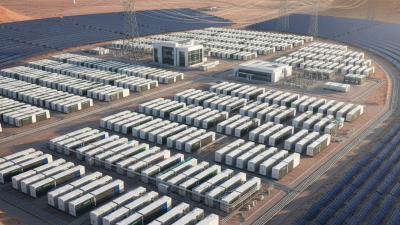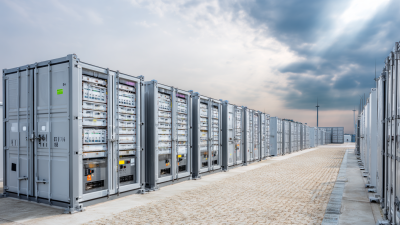Why Power Storage Batteries Are Essential for Sustainable Energy Solutions
The transition to sustainable energy solutions is rapidly gaining momentum, and at the core of this revolution lies the vital component of Power Storage Batteries. As the world strives to increase the share of renewable energy sources—projected to account for 57% of global electricity generation by 2030—efficient energy storage becomes essential (International Energy Agency, 2021). Power Storage Batteries enable the capture and storage of energy produced during peak renewable production times, ensuring a stable and reliable energy supply even when the sun isn't shining or the wind isn't blowing.

Moreover, the market for energy storage systems is anticipated to experience robust growth, with a report by Allied Market Research estimating that the global energy storage market will reach $302.02 billion by 2028, growing at a compound annual growth rate (CAGR) of 24.6% from 2021. This leap is driven not only by technological advancements in battery storage technology but also by increasing government initiatives aimed at reducing carbon emissions. As society embraces electric vehicles and renewable energy infrastructure, the role of Power Storage Batteries in enhancing grid reliability and enabling decarbonization efforts cannot be understated.
With these evolving dynamics and growing market demand, understanding how to effectively integrate Power Storage Batteries into sustainable energy solutions is more critical than ever for stakeholders in the energy sector.
The Role of Power Storage Batteries in Renewable Energy Systems
Power storage batteries play a crucial role in the integration of renewable energy systems, acting as the backbone that supports energy stability and reliability. According to the International Energy Agency (IEA), energy storage capacity is projected to grow significantly, with an estimated 1,000 gigawatt-hours (GWh) needed worldwide by 2040 to complement renewable sources like solar and wind. By storing excess energy generated during peak production times, batteries ensure that power is available when demand is high, thereby reducing reliance on fossil fuels and enhancing grid resilience.
**Tips:** To maximize the effectiveness of power storage batteries in your renewable energy setup, consider investing in high-capacity lithium-ion batteries, which currently account for about 90% of the global battery market due to their efficiency and longevity. Additionally, regularly monitoring your energy consumption patterns can help tailor the battery system to your specific needs, optimizing both storage and distribution.
The declining costs of battery technologies, driven by advancements and economies of scale, have made energy storage more accessible. BloombergNEF reports that battery prices have dropped by over 80% since 2010, making them a viable option for both residential and commercial applications. This trend not only facilitates the adoption of renewable energy but also drives innovation in how we manage energy consumption, ultimately leading to a more sustainable future.
Importance of Power Storage Batteries in Renewable Energy Systems
This chart illustrates the capacity of various types of power storage batteries, highlighting their importance in sustainable energy solutions.
Key Technologies Driving Power Storage Innovations by 2025
Power storage batteries are becoming increasingly vital as we transition toward sustainable energy solutions. By 2025, several key technologies are expected to drive innovations in this field, making energy storage more efficient, cost-effective, and accessible. One significant development is the advancement of lithium-sulfur batteries, which promise higher energy density and longer lifespans compared to traditional lithium-ion batteries. This advancement can significantly enhance the viability of renewable energy sources like solar and wind, providing a reliable supply even when generation is low.
Another critical technology is solid-state batteries, which replace the liquid electrolyte used in conventional batteries with a solid form. This shift not only improves safety by reducing the risk of leaks and fires but also increases the energy capacity and speeds of charging. As these technologies mature, they will pave the way for electric vehicles and grid storage solutions that can seamlessly integrate with existing infrastructures.
**Tips:** When considering power storage systems for your applications, look for products that utilize the latest battery technologies to ensure longevity and efficiency. Additionally, explore hybrid systems that combine different battery types, as this can enhance performance and reliability for diverse energy needs. Always investigate the environmental impact of the materials used, opting for solutions that prioritize sustainability.
Economic Benefits of Investing in Advanced Power Storage Solutions
Power storage batteries are becoming increasingly crucial in the transition toward sustainable energy solutions, primarily due to their economic benefits. Investing in advanced power storage technologies can lead to significant cost savings while enhancing energy efficiency. According to a report by the International Renewable Energy Agency (IRENA), the global energy storage market is expected to grow to over $620 billion by 2040, driven by declining costs and increasing demand for renewable energy sources. This shift not only promises to reduce reliance on fossil fuels but also fosters job creation in clean technology sectors.
Moreover, advanced storage solutions can help mitigate the intermittent nature of renewable energy sources like solar and wind. A study from the U.S. Department of Energy highlights that integrating battery storage systems can lower electricity costs by up to 30% during peak demand periods. This enables utilities to better manage energy distribution and provides consumers with more stable and lower energy prices. As the industry progresses, innovative battery technologies are emerging, with projections indicating that lithium-ion battery costs could further decrease by as much as 50% by 2030, making sustainable energy more accessible and economically viable for all stakeholders involved.
Challenges and Solutions in Mass Adoption of Energy Storage
The mass adoption of energy storage systems is pivotal to overcoming the challenges associated with integrating renewable energy into our power grids. As renewable energy sources such as solar and wind become primary power suppliers, the intermittent nature of these resources creates significant demand for reliable energy storage solutions. Thermal Energy Storage (TES) has emerged as a viable method to help address this issue, facilitating the decarbonization of buildings and improving energy stability. However, the development of effective energy management systems is crucial for consumers to navigate the complexities of today's grid, allowing them to optimize energy usage and enhance overall efficiency.
Despite the evident benefits of energy storage batteries, their widespread adoption faces several barriers, including supply chain constraints and technological limitations. For instance, Japan's shift from lithium-based batteries to sodium alternatives highlights the need for strategic pivots in energy storage to ensure supply chain resilience. Furthermore, interest in Battery Energy Storage Systems (BESS) is growing in regions like Pakistan, where decentralized energy solutions can empower local grids and improve energy accessibility. Addressing these challenges through innovation and investment will be essential for realizing a sustainable energy future and unlocking the full potential of renewable resources.
Future Trends: The Evolution of Power Storage Batteries and Their Impact
The evolution of power storage batteries has been driven by the increasing demand for sustainable energy solutions and the growing prevalence of renewable energy sources. As technologies progress, we see a shift from traditional lithium-ion batteries to innovative options such as solid-state batteries and flow batteries. These alternatives promise enhanced energy density, improved safety, and longer life cycles, which are crucial for meeting the demands of electric vehicles and grid storage solutions.
Moreover, the integration of smart technologies—such as artificial intelligence and IoT—into battery management systems is transforming how we harness and store energy. Predictive analytics can optimize charging and discharging cycles, enhancing efficiency. Additionally, the development of recycling methods for used batteries poses a significant opportunity to reduce environmental impact while ensuring a sustainable supply of materials needed for future battery production. As these trends continue to evolve, power storage batteries will play a pivotal role in facilitating a cleaner and more sustainable energy future.
Related Posts
-

How to Choose the Best Energy Storage Battery for Your Business Needs
-

Diving into Best Battery Storage Issues That Global Buyers Must Address
-

The Ultimate Guide to Maximizing Efficiency with Energy Storage Batteries: Key Trends and Innovations
-

5 Practical Tips for Maximizing Energy Storage Battery Efficiency
-

Understanding the Future of Energy Storage Battery Technology Innovations and Applications
-

5 Top Battery Storage Solutions Revolutionizing Energy Management in 2023
